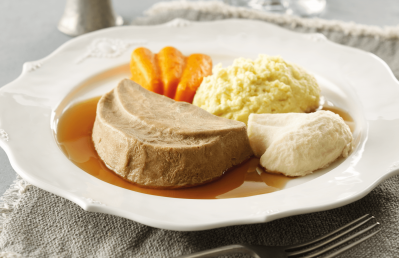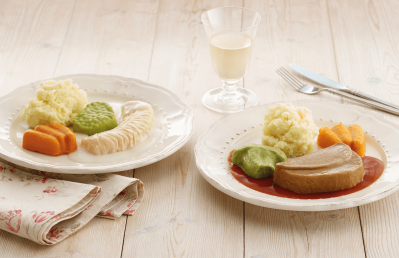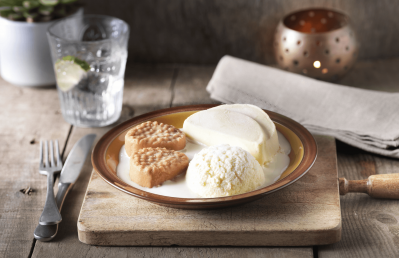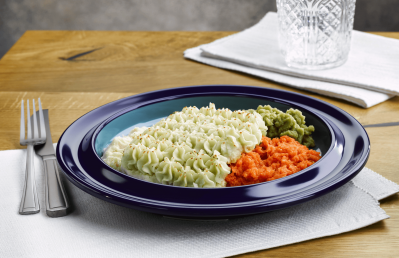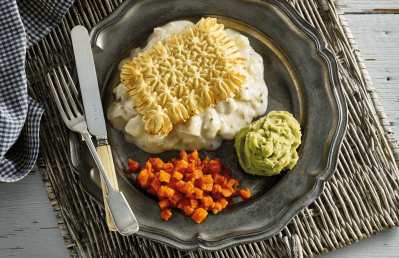What is a puréed diet?
A puréed diet or IDDSI Level 4 puréed diet must meet the following criteria:
-
Usually eaten with a spoon
-
Cannot be drunk from a cup
-
Cannot be sucked through a straw
-
Does not require chewing
-
Can be piped, layered or moulded
-
Shows some very slow movement under gravity but cannot be poured
-
Falls off spoon in a single spoonful when tilted and continues to hold shape on a plate
-
No lumps and not sticky
-
Liquid must not separate from solid
It is important that all of the criteria are met as this consistency of food is usually recommended by a speech and language therapist for the following reasons:
-
Puréed food may be used if the person cannot bite or chew food or if their tongue control is impaired
-
Puréed foods only need the tongue to be able to move forwards and back to bring the food to the back of the mouth for swallowing
-
It is important that puréed foods are not too sticky as this can cause food to stick to the cheeks, tongue, roof of the mouth or in the throat
How to prepare IDDSI Level 4 puréed diet safely at home
The following tips will help ensure that the food prepared meets the above criteria so that it is safe, nutritious and appetising.
-
Use a blender to prepare IDDSI Level 4 puréed foods
-
You will need to adjust the amount of liquid you add to obtain the right consistency. Instead of adding water, try liquids such as gravy or milk which are more nutritious.
-
Some foods will require sieving to remove lumps, particles or stringy bits
Preparing puréed meat
-
Choose tender meats such as minced beef, chicken or fish
-
Cook your meat, chicken or fish until cooked through. Do not overcook
-
Chop your meat, chicken or fish into smaller pieces for blending
-
Using your blender, purée the meat, chicken or fish until a smooth consistency is achieved
-
Gradually add liquid to the blender to get the right consistency. For example,
-
To meat, add gravy
-
To fish, add cheese sauce
-
To chicken, add a cream sauce
-
Please remember that the sauce must be smooth with no lumps
Preparing puréed vegetables
-
Parboil your vegetables. Do not fully cook through.
-
Drain all the water from your vegetables
-
Purée your vegetables using a blender.
-
You can add a cream or cheese sauce whilst blending to help bind the vegetables together and achieve the correct consistency
-
Do not blend all the different vegetables together. Blend each vegetable choice separately
Checking the consistency of the puréed food
It is important that the puréed food is of the correct consistency so that it is safe. There are two ways you can check the consistency of the food before serving.
-
Fork pressure test:
-
Smooth with no lumps and minimal granulation
-
When a fork is pressed on the surface of the food, the tines/prongs of a fork can make a clear pattern on the surface, and/or the food retains the indentation from the fork
-
-
Spoon tilt test:
-
Cohesive enough to hold its shape on the spoon
-
A full spoonful must plop off the spoon if the spoon is titled or turned
sideways; a very gentle flick (using only fingers and wrist) may be necessary to dislodge the sample from the spoon, but the sample should slide off easily with very little food left on the spoon.
-
May spread out slightly or slump very slowly on a flat plate
-
Examples of food that do not purée well
-
Nuts
-
Seeds
-
Peas*
-
Sweetcorn*
-
Coconut
-
Celery
-
Onion*
*you may be able to include these in a purée if you sieve the purée to remove any skins
Serving a puréed meal
It is important that as well as the food being the right consistency and safe for someone with dysphagia, that the food is also nutritious, visually appealing and appetising.
-
Always serve your puréed meal fresh
-
Do not add sauce or gravy to your plated puréed meal
-
You can use piping bags to pipe the puréed food into recognisable shapes such as carrots or broccoli. This will help to make the food look more appealing and appetising
-
Always check the consistency of the puréed food before serving using the food testing methods outlined above
-
Do not blend all the food components together
-
If you need to add liquid to alter the consistency of the purée, instead of using water, use cream sauces, gravy or cheese sauces. This will help to increase the nutritional value of the meal.
Always check what IDDSI level of drinks the person is taking. If they are on thickened drinks, they cannot take smooth foods that are thinner or runnier than this. For example, ice-cream, jelly or soup could be aspirated. Always seek the advice of a speech and language therapist.
Is puréed food healthy?
As well as preparing puréed food that is safe, appealing and appetising, it is important to ensure your food is also nutritious.
The nutrients that your body requires to achieve a healthy, balanced diet are:
-
Fruits and vegetables - eat at least 5 portions of fruit and vegetables per day
-
Starchy carbohydrates such as pasta, rice, cereals
-
Dairy or dairy alternatives such as milk, yoghurts and cheese are a good source of protein and vitamins such as calcium
-
Beans, pulses, eggs, meat and fish - these foods are all important sources of protein, vitamins and minerals
-
Oils and spreads - fats are important in the diet but choose unsaturated fats such as olive oil and sunflower oil
Ensuring the puréed food you eat is well balanced will help to maintain a healthy food intake and receive the nutrients your body needs.
However, it is important that you have adequate nutritional intake to meet your nutritional needs whilst following a puréed diet. It is common for people who need to have puréed food to make sure they get extra calories and protein in their diet to reduce their risk of malnutrition and prevent unintentional weight loss. You may be advised by your dietitian to have snacks in between your meals, choose energy dense foods and to fortify your food using everyday items such as milk, cream and butter.

